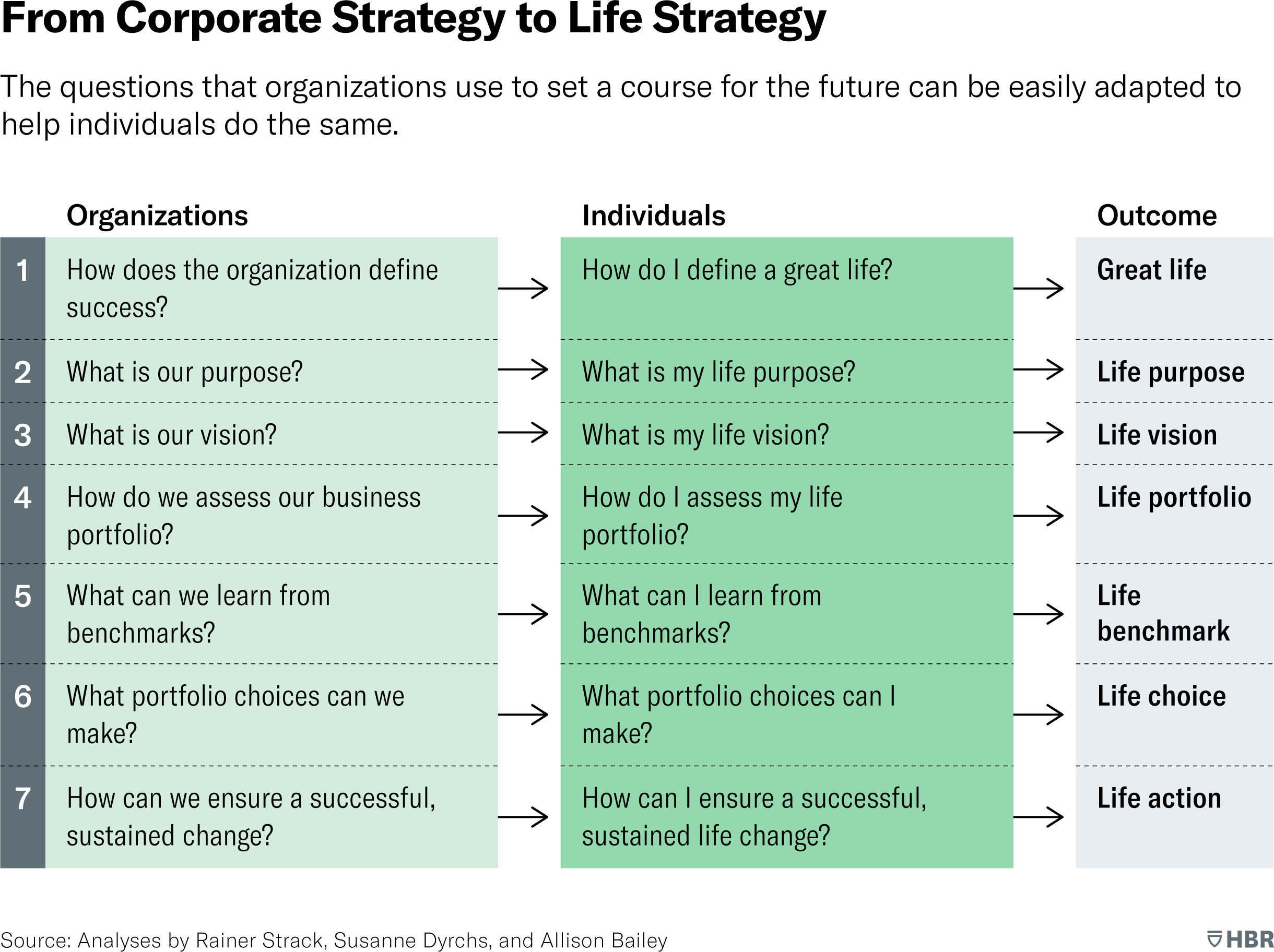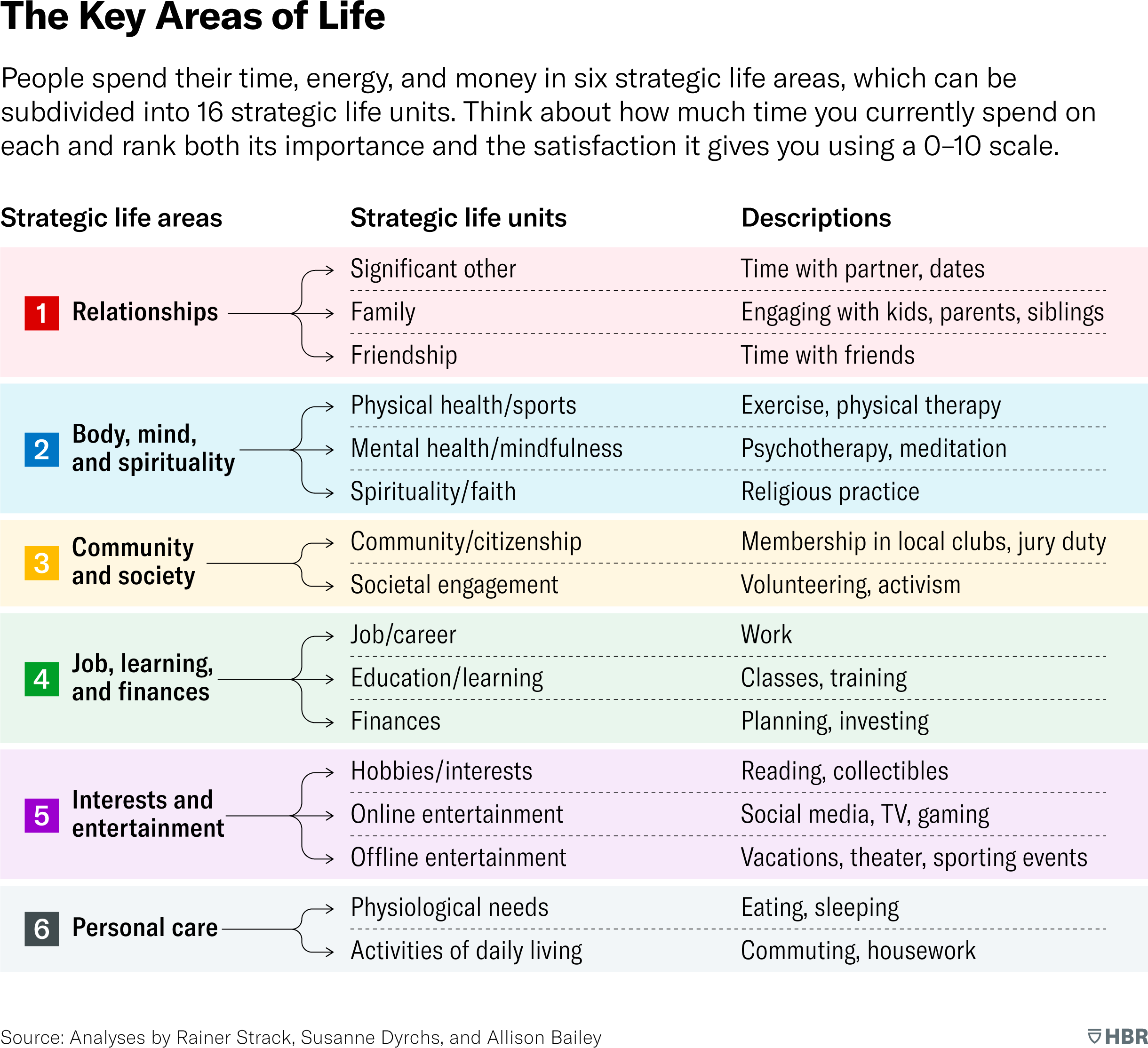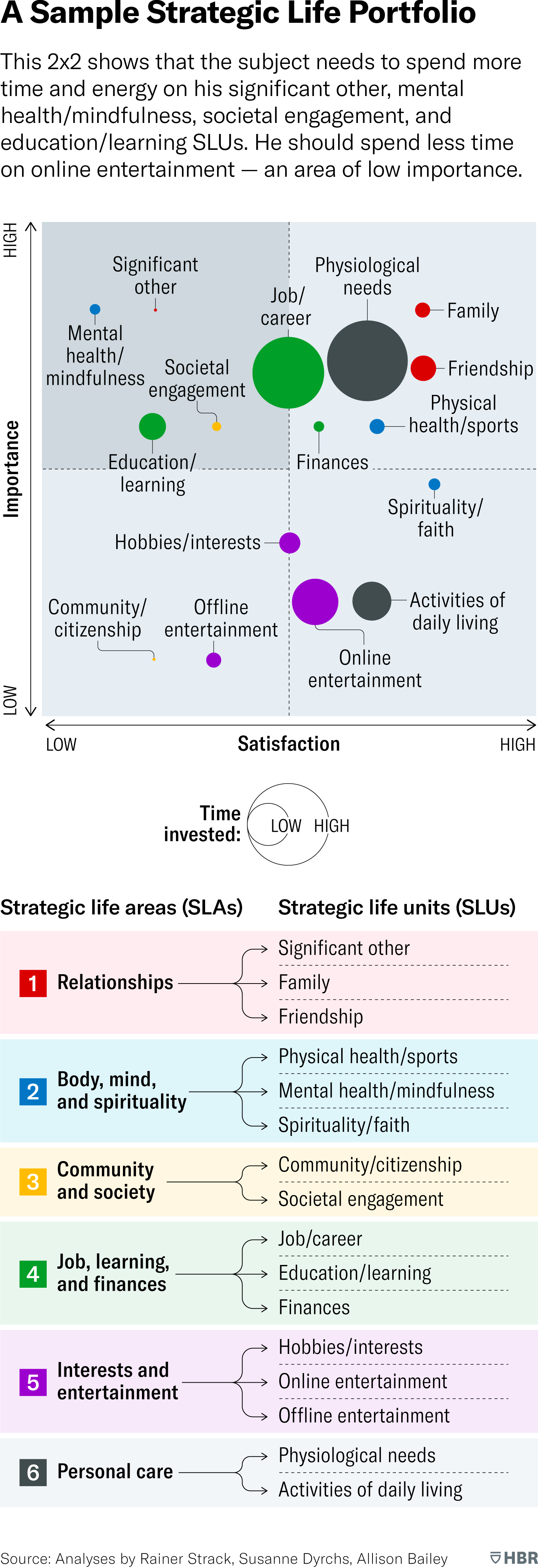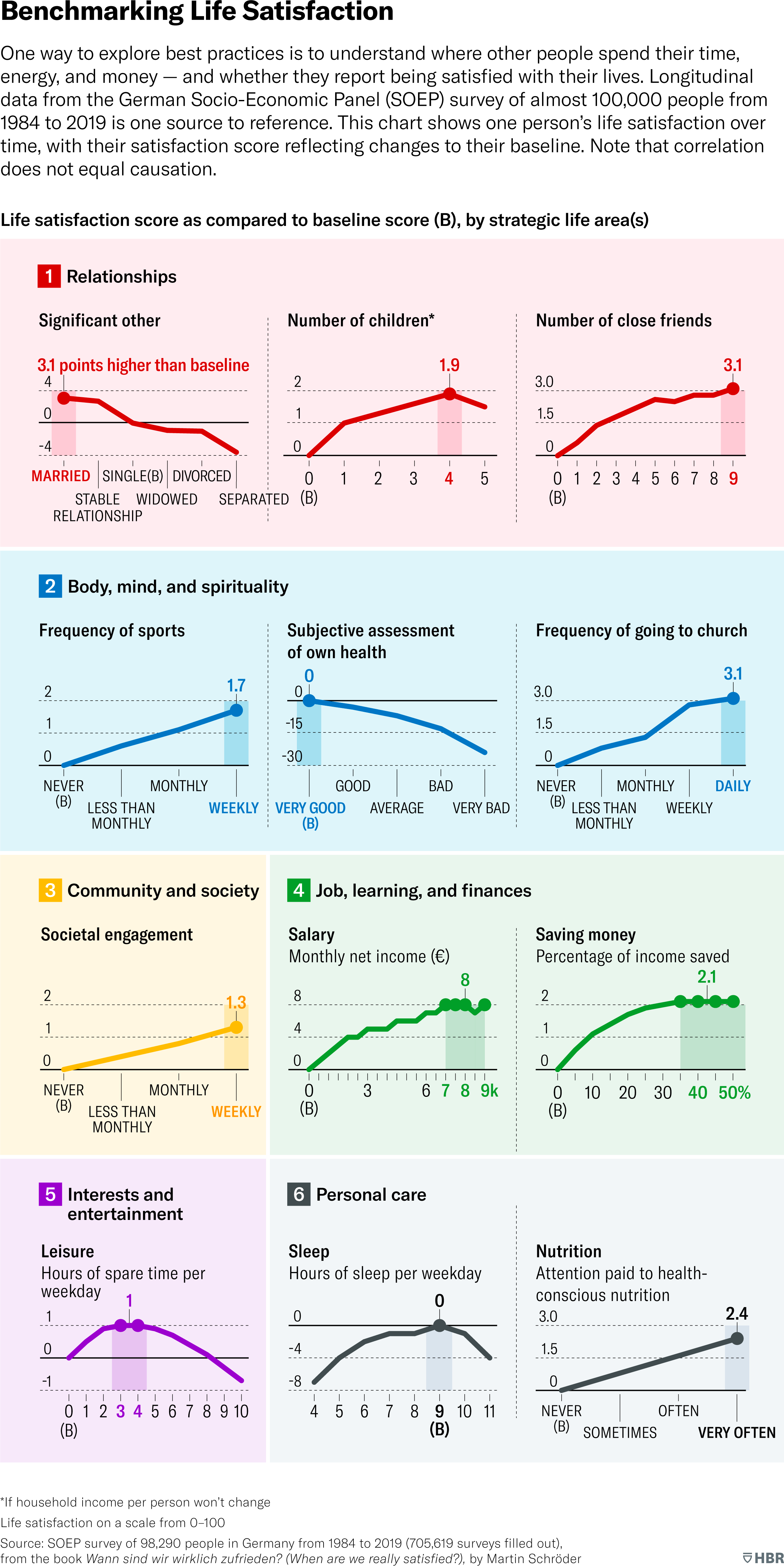In times of crisis, many of us ponder existential questions about health, security, purpose, career, family, and legacy. However, more often than not, such contemplation is short-lived. The demands of everyday life — the here and now — can overwhelm us, leaving little time to think about the long term and what we are working toward. As a result, when faced with life decisions both big and small, we are left with nothing to guide us but emotion or intuition.
The corporate equivalent, of course, is attempting to run a business without a strategy, which every HBR reader knows is a losing proposition. But as longtime consultants to organizations around the world, we wondered: Could we adapt the model for strategic thinking that we use with institutional clients to help individuals design better futures for themselves? The answer is yes, and the result is a program that we call Strategize Your Life. We’ve tested it with more than 500 people — including students, young professionals, middle-aged employees and managers, C-suite executives, board members, and retirees — to help them develop their individual life strategies.
You can create a life strategy at any time, but it can feel especially appropriate at certain milestones — a school graduation, the start of your first job, a promotion, becoming an empty-nester, retiring — or after a major life event, such as a health scare, a divorce, the loss of a job, a midlife crisis, or the death of a loved one. When you have a strategy, you will be better able to navigate all those transitions and difficult moments, building resilience and finding more joy and fulfilment while minimizing stress. This article will help you get started.
A Surprising Symmetry
Every corporate strategy project is different. But the hundreds that we’ve conducted for large organizations have had commonalities, including the use of certain methodologies and tools. We typically work through seven steps, each guided by a question:
- How does the organization define success?
- What is our purpose?
- What is our vision?
- How do we assess our business portfolio?
- What can we learn from benchmarks?
- What portfolio choices can we make?
- How can we ensure a successful, sustained change?
These steps can be easily adapted to an individual:
- How do I define a great life?
- What is my life purpose?
- What is my life vision?
- How do I assess my life portfolio?
- What can I learn from benchmarks?
- What portfolio choices can I make?
- How can I ensure a successful, sustained life change?
As the former head of strategy for a U.S.-based Fortune 50 company told us, “Knowing the right questions is much harder than having the answers.” Just as corporate strategy is an integrated set of choices that positions a company to win, life strategy is an integrated set of choices that positions a person to live a great life. What’s more, we can apply tools from classic organizational strategy and other realms to help you find answers to the seven questions above and make better decisions.
Critics might say that you can’t transfer concepts from business to life. In the 1960s there were similar concerns about whether strategy ideas from the military and politics could apply to the corporate world. The management guru Peter Drucker even changed the title of his 1964 book from Business Strategy to Managing for Results because everyone he and his publisher asked told them that strategy belonged to those realms, not to business. Yet we’ve also seen business-world principles employed to improve people’s self-management. For example, in their best-selling book Designing Your Life, Stanford University’s Bill Burnett and Dave Evans modified the design thinking they used in software development to help individuals.
Strategize Your Life is our attempt to do the same for strategic thinking in a concrete, step-by-step way. We believe it can lead you to new insights on how you define and find your great life. Our goal is to give your emotion and intuition an analytical partner.
In surveying our workshop and coaching session participants, we found that, in the past, only 21% had outlined what a great life means to them, 9% had identified their purpose, 12% had set a vision for their life, 17% had created concrete goals and milestones, and a paltry 3% had developed what could be called a life strategy. These are critically important issues that very few of us are spending enough time on.
Strategize Your Life:
Series reprint
As Martha, a 26-year-old graduate student, explained, “Life keeps taking shape… When all the Christmas parties and weddings and trips are suddenly over, you ask yourself, ‘Have I really lived or has life just happened to me?’” She was eager to be more proactive. “What better help is there than a high-level plan for life?” she asked. “Not to strictly follow it and forbid life to unfold, but to have a common thread. What should my story be? What should I have experienced so that in the end I can say to myself, ‘I have lived’?”
Unlike most self-help books, we don’t present one golden path to happiness or life satisfaction. Because everyone is unique, we give you the tools to find your own path in a seven-step life strategy process. In step 1 you define what a great life means for you. In step 2 you outline your purpose; in step 3 your life vision. Step 4 is a portfolio analysis of how you spend your 168-hour week, while step 5 involves setting life satisfaction benchmarks. In step 6 you incorporate the results of the first five steps and determine your choices and potential changes in your life, and in step 7 you map out a plan for putting your choices into action. We recommend that you take notes throughout so that, by the end, you can put an initial version of your life strategy on a single page. (To help, we created a life strategy worksheet, which should be filled out after you’ve gone through all the steps.)
This work may seem daunting, but in practice it should take you only a few hours. That said, it might not be easy. You will have to challenge yourself and go beyond the obvious. But you shouldn’t give up, because the answers you’ll discover are so worthwhile. After all, what’s more important than your life? Commit to thinking strategically about it, look forward to the insights you will gain, and enjoy the journey.
The Seven Steps
The process begins with a simple yet profound question:
1. How do I define a great life?
The starting point of any corporate strategy process is to define fundamental metrics for success. For instance, does the organization want its strategy to focus on driving sales, shareholder value, or positive societal impact?
What are the right metrics in an individual’s life? Our social norms and hierarchies might suggest we measure ourselves with money, fame, and power. But studies have shown that money leads to greater happiness only to the extent that our basic needs are met, after which its returns diminish or even plateau. Other research shows many of us are on a “hedonic treadmill”: After we get a pay raise, are promoted, or purchase something that triggers a pleasurable high, we return to our original level of happiness. And then there is social comparison — no matter what you achieve, someone will always be richer, more famous, or more powerful than you.
The ancient Greeks saw two main dimensions of a great life: hedonia (a focus on pleasure) and eudaimonia (a focus on virtues and on meaning). More recently, scholars have pointed to the importance of social connection. A study of more than 27,000 people in Asia found a strong correlation between being married and being satisfied with life, while a study that has followed 268 Harvard College men from 1938 to the present, and was expanded to include their children and wives, as well as a study that has followed 456 residents of inner-city Boston since the 1970s, also expanded to include children and wives, found that meaningful relationships were the key driver of long-term happiness. The late Harvard Business School professor Clayton Christensen agreed: In his classic HBR article “How Will You Measure Your Life?” he wrote, “I’ve concluded that the metric by which God will assess my life isn’t dollars but the individual people whose lives I’ve touched.”
A framework that includes all these factors — hedonic, eudemonic, and relational — is the PERMA model, introduced by Martin Seligman, the founder of positive psychology and a University of Pennsylvania professor, in his 2011 book, Flourish. Other researchers later developed it into PERMA-V, which stands for Positive emotions (frequent feelings of pleasure and contentment), Engagement (being in the flow, losing track of time), Relationships (mutual feelings of caring, support, and love), Meaning (contributing to making the world a better place), Achievement (striving for success or mastery, reaching goals), and Vitality (being healthy and energetic).
To determine what makes a great life for you, start with each element in PERMA-V, or even add your own categories, such as autonomy or spirituality. Then rate each one’s importance to you on a scale from 0 (not important) to 10 (very important). Try to recall periods of deep satisfaction in your past and consider what triggered them.
In the first step of strategy projects, we conduct a comprehensive analysis of the status quo. So, you should also rate your current satisfaction with each dimension on a scale from 0 (not at all satisfied) to 10 (very satisfied). This quick assessment will give you a rough idea of how you define a great life and initial ideas about what you need to change.
2. What is my life purpose?
For a corporate strategy to be successful, it must be anchored to the organization’s purpose, which lies at the intersection of, What are we good at? and What does the world need?, and takes into account, What are our values? and What excites us? Using these questions, we’ve helped companies around the world develop purpose statements. A purpose statement serves as an important guardrail for your strategy and is a North Star for your organization.
The same questions can be used to find your life purpose. Ask yourself, What am I good at? Think about situations at work or in other areas of life in which you have demonstrated critical strengths such as creativity, teamwork, or communication. Then ask, What are my core values? Think about critical decisions you’ve made and principles you hold dear that have provided direction, such as honesty, fairness, or integrity. There are dozens of online lists and tests to help you consider your most important values. The next question is, Which activities light me up? Perhaps your answers include mentoring, problem-solving, or engaging with different types of people. Finally, ask, What need can I help address in the world? It could be one of the 17 Sustainable Development Goals of the United Nations, such as health, education, gender equality, or climate action, or it could be something much more general, such as love, kindness, trust, or security.
In the purpose-defining stage of strategy projects, we conduct belief audits to get input from many stakeholders. Do the same. Ask friends or family members what your strengths are, what values you live by, what things excite you, and what need you might help fill.
Draw from your own answers and theirs to draft a purpose statement, and then ask for feedback on it. Or you can engage ChatGPT in an interactive dance, using the answers to the four questions as input to help you develop your purpose statement, as Tom, a climate physicist, did in one of our recent workshops.
When Joudi, a Kurdish refugee from Syria currently living in Germany, went through this exercise, he identified his core strengths as ambition, passion, and hunger for knowledge. His core values were justice, peace, family, and charity. He said he was most excited by innovation, neurosurgery, and entrepreneurship (notably his experiences selling accessories as a street vendor in Istanbul and founding a multilingual AI-powered integration support platform for Ukrainians who had fled their country for Germany). As for the world needs he wanted to address, Joudi cited health care, freedom, and equality. In the end, he wrote this purpose statement: “Remain medically passionate, willing to learn, entrepreneurial, and strong-willed to drive medical innovation and create equitable access to health care for people.”
A chief human resources officer at a global industrial company wanted to step down from her current role but was unsure whether she should look for a similar role in another company or do something completely different. She went through the seven steps and came up with a simple purpose statement, “To help and lead others to aspire,” through which she realized that she did want another senior HR role, just in a different company.
There are other methods for defining one’s life purpose, of course. But it’s important to find the time and a way to do it. We’ve seen some workshop participants sharpen their existing purpose ideas, while others have had a real “aha” moment, finally understanding what they were meant to do. Purpose guides your life strategy.
3. What is my life vision?
The next step in building a corporate strategy is to set out a vision for the future. We typically ask leadership teams where they want their organization to be — in terms of innovation, growth, product portfolio, market presence, etc. — in five to 10 years. Often we have them ask themselves questions like, What newspaper headline about our company would we like to read a decade from now?
Individuals should also strive to envision who they want to become in the years ahead. As the Stoic philosopher Seneca said, “If you do not know which port you are sailing to, no wind is favorable.” At the same time, you want to remain open to surprises and serendipity. Seneca commented on this as well: “Luck is what happens when preparation meets opportunity.” Strategizing your life is the preparation.
So, ask yourself: What story would I like people to tell about me five to 10 years from now? What would I do if money wasn’t an issue? What will the 80-year-old me not want to have missed in life? Your purpose and your strengths might also trigger some ideas about your vision.
For this step we have used a photo-sorting exercise similar to what our corporate clients use in branding and innovation strategy projects. Out of 180 photos, workshop participants select two to four that best represent their personal and professional vision — what one person described as a “mood board.”
In both business and individual life strategy, a vision can give you focus. Jim, who will soon be a doctor, had a purpose statement that was rather general: “Bring people together and share passions.” His vision was more concrete and specific: “To create spaces for more social encounters, such as a medical practice with a shared coffee shop, and to get involved in homeless medicine.” Your vision should be equally descriptive.
You might end up with a short list of bullet points or a one-sentence summary of your vision. No matter how you capture it, a vision statement can be powerful in guiding your life. An example we love comes from our colleague Sebastian when he was 14. After a poor math test result, his teacher told him, “Teaching you is a waste of time” and warned he’d never get a high school diploma. For the next couple of years Sebastian took that to heart, skipped school, and started working as a bricklayer. Eventually, however, he decided to make a change, and it began with this vision statement: “I will go to university and get a PhD and then go back to my math teacher — all in the next 10 years.” He did just that, graduating summa cum laude with a PhD in economics, and in another 10 years he was a managing director and a partner at BCG.
4. How do I assess my life portfolio?
Companies typically use portfolio analysis to assess their business units on key parameters such as market growth or share and to decide where to invest capital. BCG is well-known for its 2×2 growth-share matrix.
But what is the equivalent of a business unit in life? We focus on six strategic life areas (SLAs): relationships; body, mind, and spirituality; community and society; job, learning, and finances; interests and entertainment; and personal care. We then subdivide the six SLAs into 16 strategic life units (SLUs). (For a full list of the SLUs, see the exhibit “The Key Areas of Life.”)
And what are the equivalents of capital expenditures in life? Time, energy, and money. A week has 168 hours. How do you spend them? With your significant other, with family, at work, playing sports, at church, getting a good night’s rest?
Look back at the past year, including holidays, and assess how much time you spent on each of the 16 SLUs in an average week. When an activity crosses categories, split the time between them. For example, if you went jogging with your significant other for one hour a week, allocate half an hour to the significant other SLU and half an hour to the physical health/sports SLU. Next, rate all 16 SLUs on a scale of 0 to 10 based on how important they are to you. Then rate the satisfaction you derive from each on the same scale. (This goes one level deeper than the similar PERMA-V exercise.)
Now sketch out your own 2×2; we call it the Strategic Life Portfolio. But instead of mapping growth against share, you will put the importance of each SLU on the y-axis and the satisfaction it brings on the x-axis. Plot each SLU with a bubble, making the size of the bubble roughly proportional to the percentage of time in a week you spend on it.
In the top-left quadrant, you will find the SLUs of high importance and low satisfaction. These are areas of high urgency, because you care about these activities deeply but aren’t focusing on them enough to get the most out of them. The SLUs in the top-right quadrant also deserve some attention: You want to keep devoting significant time and energy to your most important and highest-satisfaction activities, and invest less in those that are less important (bottom left and right).
Finally, look at your entire 2×2 and ask yourself: Does my current portfolio of SLUs put me on the right track to support my purpose and achieve my vision? Does it bring me closer to how I define a great life? Where can I save and reallocate my time? Just as in corporate strategy projects, you want to set some high-level priorities — rather than a detailed plan — for investments of your time, energy, and money.
When Toni, an engineer, completed this exercise, he saw four areas for urgent improvement in the top-left quadrant: significant other (since he didn’t have one), mental health/mindfulness, societal engagement, and education/learning. His job/career SLU was split between two quadrants, and he was spending too much time on online entertainment, which charted in the bottom-right quadrant. It became clear to Toni what he needed to change.
5. What can I learn from benchmarks?
In almost every strategy project, we do a best practice and benchmarking analysis to understand what we can learn from leading companies. We can do the same for individuals by looking at role models and then, more importantly, at the research on life satisfaction.
Ask yourself: Who conducts their personal and professional life in a way I admire? Maybe it is a coworker caring for his bedridden parent, the mother of three at your kids’ school who also manages payroll for a Fortune 500 company, or your religious leader who lives his purpose. Ask yourself what makes them admirable, and what choices they would make if they were in your shoes.
Now consider what scientific studies tell us about life satisfaction — not anecdotally but across large populations. We already mentioned the Harvard and Asia studies. One of the largest studies worldwide on life satisfaction is the German Socio-Economic Panel survey, which covered almost 100,000 people from 1984 to 2019, gathering more than 700,000 completed responses. It found that significant others, children, friends, sports, spirituality, community involvement, salaries, savings, and nutrition all contribute to life satisfaction. Not surprisingly, health problems have a very negative impact, and you can find an optimum amount of time to spend on leisure and sleep.
Other studies have found that proven life-enhancers include practicing kindness, mindfulness, meditation, and gratefulness; cultivating more humor and laughter; dedicating time to learning; and developing a growth mindset (that is, believing your abilities and life can improve through effort and persistence).
As you do this work, it’s important to understand and learn from what has worked for others, while also remembering that you can’t just copy and paste someone else’s approach. Your life strategy should be unique to you.
6. What portfolio choices can I make?
Corporate strategy is about making choices between options: Should we keep our current portfolio, diversify, focus, acquire a company, or enter a new market? In life, the equivalent questions are: What happens if I continue to live my life the way I am now? What if I change my priorities? Equipped with your definition of a great life, your purpose, your vision, your SLU ratings, and your benchmarks, you are ready to find out.
Go back to the great-life exercise in step 1 and think about what you can do for your areas of dissatisfaction. Review your purpose and vision from steps 2 and 3 and brainstorm how you might realize them. Think about the SLUs that step 4’s portfolio exercise identified as needing more attention, and how you can improve satisfaction or reallocate time there. Then consider how the insights gleaned from step 5’s benchmarks can help you with all of the above. From this long list of potential changes and actions — small and large — select several that will best move you toward a great life, and commit to them.
Now you need to be specific about what you want to change. Examples from our workshop attendees include reconnecting with three friends from school, visiting one’s grandpa every week, engaging in a weekly micro-adventure with one’s significant other, changing jobs, committing to a new sleep schedule, trying a meditation app, starting a gratitude journal, spending more time with one’s kids, exercising every day, supporting refugees, starting a social business, practicing religion again, dedicating 15 minutes to learning every day, switching college majors, converting a van into a camper to travel, and moving abroad. The possibilities are endless.
On the other hand, you have only 168 hours each week, which means you must reduce, outsource, or bundle existing activities, or make them more efficient through productivity strategies and tools. For example, when you work out with your boyfriend or volunteer for a good cause with your friends, you are bundling sports and significant other or societal engagement and friendship. Life strategy is about setting priorities; it is not about filling every waking minute. Remember to reserve space in your calendar for downtime as well. Researchers at the University of Pennsylvania’s Wharton School and UCLA’s Anderson School of Management found that people are happiest when they have two to five hours of free time each day.
When Judi, a workshop attendee, finished making her list of actions, she commented, “If I change all this, I will be a different person in a few weeks.” Your life strategy could involve big steps like starting a business, traveling the world (as one of us did), or setting up an NGO, or it could involve a small step like meeting for coffee every week with people you care about. Even a small change can have a big impact in two key ways. First, if you do it over and over again, you take advantage of the compound growth rate. Second, you are a node in a network of people, so your change not only affects those close to you but also ripples outward. After all, sometimes big changes are triggered by small, seemingly insignificant actions — the famous butterfly effect. For example, research has shown that doing just 15 minutes of physical activity a day increases life expectancy by three years (despite amounting to only about half a year of time investment). Exercise also gives you a dopamine boost, improving your mood, which benefits those around you and makes you more productive at work, potentially leading to new outputs that greatly impact the lives of others.
If you know which strategic life unit needs work but don’t know what changes to make, dig deeper and develop a substrategy for that unit — a job/career strategy, a family strategy, a mental health/mindfulness strategy, and so on — just as each business unit does with the overarching corporate strategy.
For example, to develop a job/career strategy, ask yourself the following questions: How does my current job support my purpose and vision? Does my current job give me a sense of achievement and engagement (two of the six great-life dimensions)? How does my current job align with the strengths I identified in the purpose step? Finally, look for benchmarking data, such as BCG’s Decoding Global Ways of Working study, where we list the top 10 criteria of great jobs according to more than 200,000 respondents. Again, rate how your job measures up to these criteria. The answers to these questions will give you an idea of how to move forward in your career.
7. How can I ensure a successful, sustained life change?
Change is not easy. Need proof? More than 40% of Americans set New Year’s resolutions each January, and reports indicate that more than 90% fail to follow through on them.
Many companies, such as Google, ensure successful implementation of the strategies they’ve outlined by using OKRs (objectives and key results). OKRs are focused, ambitious, output-oriented, flexible, measurable, and transparent.
We recommend doing the same for each of the changes you committed to in step 6. Define the broad objective and the date by which you want to achieve it. Then break down each of those objectives into a few key results or action items, again with deadlines. Consider adding them directly to your calendar. If you are unsure about implementing a big move in your life, experiment. For example, Toni identified mental health/mindfulness as a high priority, so he might set an objective of “Download an app and try meditation techniques for 10–15 minutes a day (finish by the end of November).” He could then break it down into two key results: (1) review meditation apps and get started (first week of November), and (2) try an app for three weeks, review the experience, and make it a daily habit (last three weeks of November).
There are many ways that companies hold themselves to OKRs. Here, we focus on three of them. Anchoring means sharing your plan, as Google does by making its OKRs public. Who will you tell about your plan or ask to join you on your journey? Strategy projects always involve small teams, so consider not only seeking input from others but also inviting one or two people to work on their own life strategies and then workshop everyone’s results as a group. Consequences means setting up incentives for achievement, such as bonuses for success or penalties for failure. How will you reward yourself when you’ve successfully changed an aspect of your life, and what will the consequences be if you don’t? And check-ins means routinely stepping back, refining and adjusting your efforts, and celebrating your achievements, as agile project development teams do. When each week can you spend 15 minutes to review and update your life strategy?
Toni, for example, might tell a friend to hold him to his changes, promise to donate a significant amount of money to a charitable cause if he doesn’t stick to them, and schedule a weekly check-in with himself every Sunday before his study session.
Your One-Page Life Strategy
Often, the seeming enormity of an important task — like life strategy development — is what stops us from doing it. So, to make what seems impossible possible, we recommend recording your entire life strategy on a single sheet of paper or in a single location. If you have finished the exercises in this article, you can easily do this. To start, write down what defines a great life for you. Next, record your strengths, your values, what lights you up, and what the world needs, and then add your purpose statement that incorporates those ideas. Third, summarize your life vision. Fourth, refer to that 2×2 you sketched and note the SLUs that are high priorities for action or that you spend too much time on. Next, write down the changes you’d like to make and commit to. Finally, for each of those changes, list an objective and two to three key results with deadlines, and then note the anchors, the consequences, and the check-in plan to make the change stick.
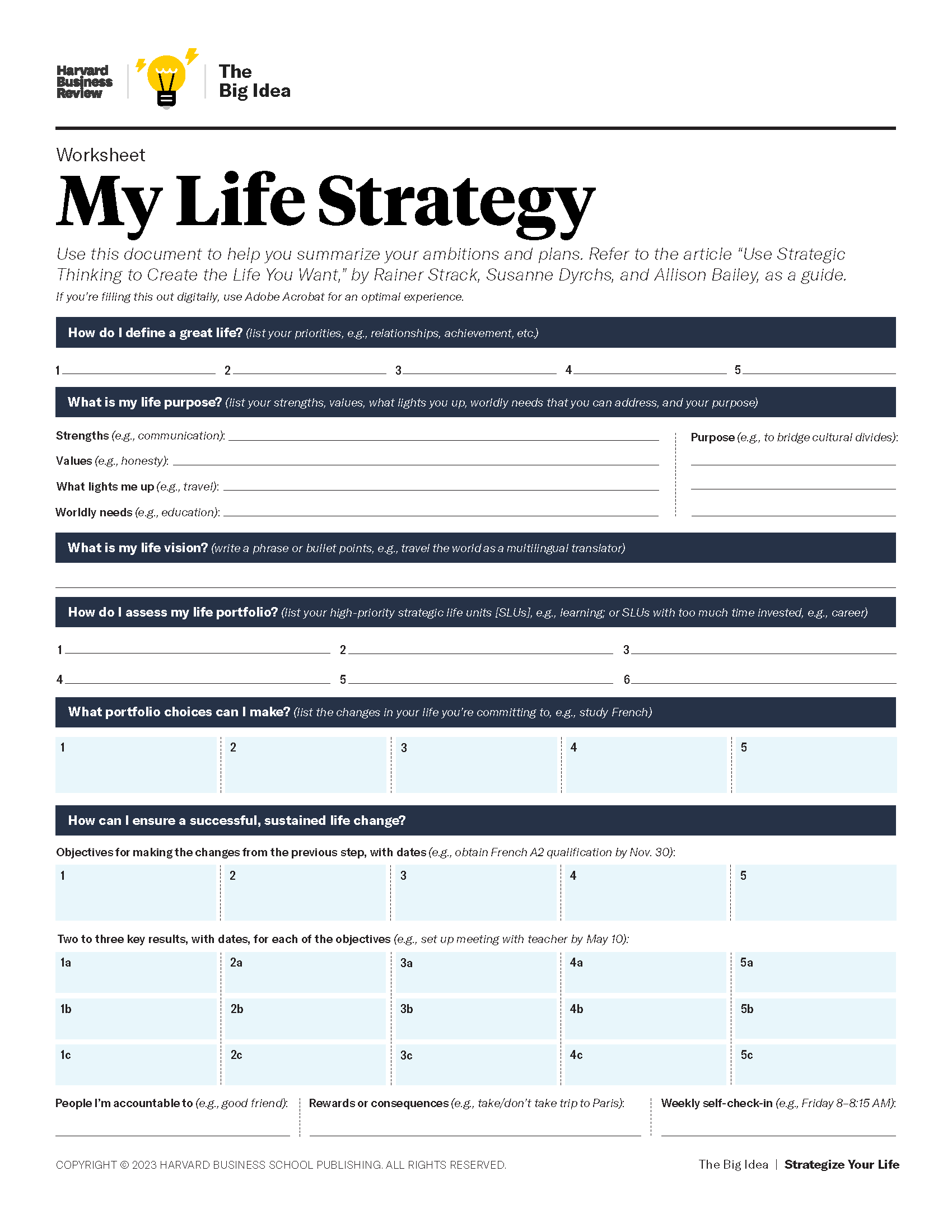
This page is your first minimum viable life strategy. As with corporate strategy, it needs to be reviewed, adjusted, and updated on a regular basis. Proprietary data from BCG suggests that 50% of companies review their strategy once a year, and 20% more than once a year — what we call always-on strategy development. Likewise, in addition to your weekly 15-minute check-in, we recommend scheduling a longer, one- to two-hour review session with yourself, or with the life strategy group you started with other people, every six to 12 months. Review all seven steps, consider setbacks or shifting circumstances, and adjust accordingly.
The chief human resources officer we mentioned earlier puts her one-pager on top of all the papers on her desk. She looks at it every day to reinforce her belief in what makes a great life and to ensure she executes on her strategy for achieving it; when she has an idea for refinement, she writes it down. You can try that, too. A couple we worked with, who wanted to develop life strategies in tandem, went so far as to document their life purposes and goals with photos and notes in a picture frame. They hung it on the wall of their home, a daily reminder of where they want to go both together and as individuals.
Life is full of adventure and trauma, love and sadness, joy and stress. It can be great or terrible. There will be ups and downs. But a lot of it depends on you and the choices you make. A life strategy will not only guide you but also build your resilience so that you’re better able to recover from missteps.
Sophia, a doctor who suffered from a serious chronic illness, wrote to us after attending a workshop: “I realized I want to make more decisions, do really crazy things, enjoy small and big moments, celebrate successes, go to places I’ve never been, meet people I’ve never seen before, take breaks in between, follow my flow, and make myself my most important project in life!”
Now, go and do the same. Your life is your top strategic priority.




